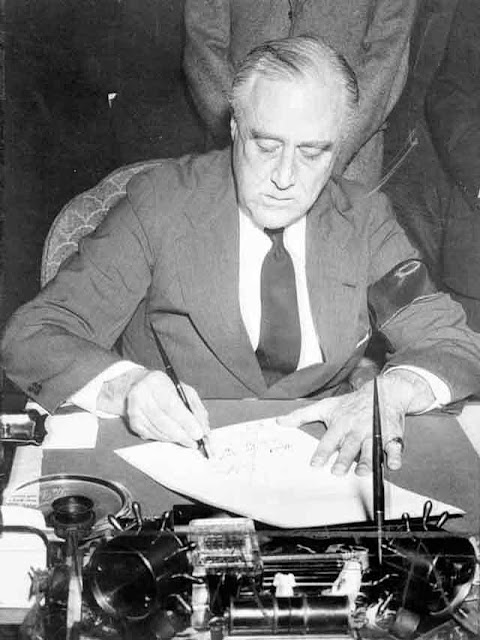Thursday 11 December 1941
 |
| Adolf Hitler and cronies during his speech at the Kroll Opera House on 11 December 1941. |
Joint Resolution Declaring That a State of War Exists Between The Government of Germany and the Government and the People of the United States and Making Provisions To Prosecute The Same.Adolf Hitler gives a long speech to the Reichstag at the Kroll Opera House explaining this decision. President Roosevelt, however, merely sends down a written request to Congress asking for a declaration of war.
The Reich's declaration of war against the United States is considered Hitler's worst blunder of the war, topped only, perhaps, by his invasion of the Soviet Union. The reasons for Hitler's decision are debated, but his previous speeches indicate a deep resentment about the United States for flouting the international rules of warfare in support of Great Britain. Another possible motivation is to draw attention away from the Eastern Front, where the Wehrmacht is reeling due to the Red Army counteroffensive at Moscow. Hitler also is a creature of the Great War, and many of his strategies mirror those taken by the German Empire in that conflict. In this instance, Hitler adopts the thinking of the German high command in 1917 that unrestricted submarine warfare could finally isolate England and cause its eventual starvation and surrender. This would prevent United States intervention on the Continent and free the Reich's military to finally subdue the USSR. The strategy did not work in World War I, but perhaps Hitler thinks that the United States Navy is inadequate to fight a two-ocean war. In any event, the Reich is not bound by a treaty to support the Empire of Japan. While the Japanese Ambassador has sought such written assurance, the Reich has not provided them. In any event, Hitler never shows much deference to treaties regardless of how applicable they may be. This is Hitler's decision alone, made after four days of consideration, and stands as his only formal declaration of war.
 |
| President Roosevelt signs the declaration of war against Germany, 11 December 1941. |
 |
| Destruction at Wheeler Field in Hawaii, as photographed on 11 December 1941. |
 |
| Judy Garland and Lana Turner on the set of "Ziegfeld Girl," 11 December 1941 (Clarence Sinclair Bull, via The Judy Garland Experience). |
The Reich's Declaration of War upon the United States:
MR. CHARGE D'AFFAIRES:
The Government of the United States having violated in the most flagrant manner and in ever increasing measure all rules of neutrality in favor of the adversaries of Germany and having continually been guilty of the most severe provocations toward Germany ever since the outbreak of the European war, provoked by the British declaration of war against Germany on September 3, 1939, has finally resorted to open military acts of aggression.
On September 11, 1941, the President of the United States publicly declared that he had ordered the American Navy and Air Force to shoot on sight at any German war vessel. In his speech of October 27, 1941, he once more expressly affirmed that this order was in force. Acting under this order, vessels of the American Navy, since early September 1941, have systematically attacked German naval forces. Thus, American destroyers, as for instance the Greer, the Kearney and the Reuben James, have opened fire on German submarines according to plan. The Secretary of the American Navy, Mr. Knox, himself confirmed that-American destroyers attacked German submarines.
Furthermore, the naval forces of the United States, under order of their Government and contrary to international law have treated and seized German merchant vessels on the high seas as enemy ships.
The German Government therefore establishes the following facts:
Although Germany on her part has strictly adhered to the rules of international law in her relations with the United States during every period of the present war, the Government of the United States from initial violations of neutrality has finally proceeded to open acts of war against Germany. The Government of the United States has thereby virtually created a state of war.
The German Government, consequently, discontinues diplomatic relations with the United States of America and declares that under these circumstances brought about by President Roosevelt Germany too, as from today, considers herself as being in a state of war with the United States of America.
Accept, Mr. Charge d'Affaires, the expression of my high consideration.
December 11, 1941.
RIBBENTROP
 |
| Hermann Goering, upper left, presides over the Reichstag as Adolf Hitler declares war upon the United States. |
December 1941
December 1, 1941: Hitler Fires von Rundstedt
December 2, 1941: Climb Mount Niitaka
December 3, 1941: Hints of Trouble in the Pacific
December 4, 1941: Soviets Plan Counteroffensive
December 5, 1941: Soviets Counterattack at Kalinin
December 6, 1941: Soviet Counterattack at Moscow Broadens
December 7, 1941: Japan Attacks Pearl Harbor
December 8, 1941: US Enters World War II
December 9, 1941: German Retreat At Moscow
December 10, 1941: HMS Prince of Wales and Repulse Sunk
December 11, 1941: Hitler Declares War on the US
December 12, 1941: Japanese in Burma
December 13, 1941: Battle of Cape Bon
December 14, 1941: Hitler Forbids Withdrawals
December 15, 1941: The Liepaja Massacre
December 16, 1941: Japan Invades Borneo
December 17, 1941: US Military Shakeup
December 18, 1941: Hitler Lays Down the Law
December 19, 1941: Brauchitsch Goes Home
December 20, 1941: Flying Tigers in Action
December 21, 1941: The Bogdanovka Massacre
December 22, 1941: Major Japanese Landings North of Manila
December 23, 1941: Wake Island Falls to Japan
December 24, 1941: Atrocities in Hong Kong
December 25, 1941: Japan Takes Hong Kong
December 26, 1941: Soviets Land in the Crimea
December 27, 1941: Commandos Raid Norway
December 28, 1941: Operation Anthropoid Begins
December 29, 1941: Soviet Landings at Feodosia
December 30, 1941: Race for Bataan
December 31, 1941: Nimitz in Charge
2020



No comments:
Post a Comment